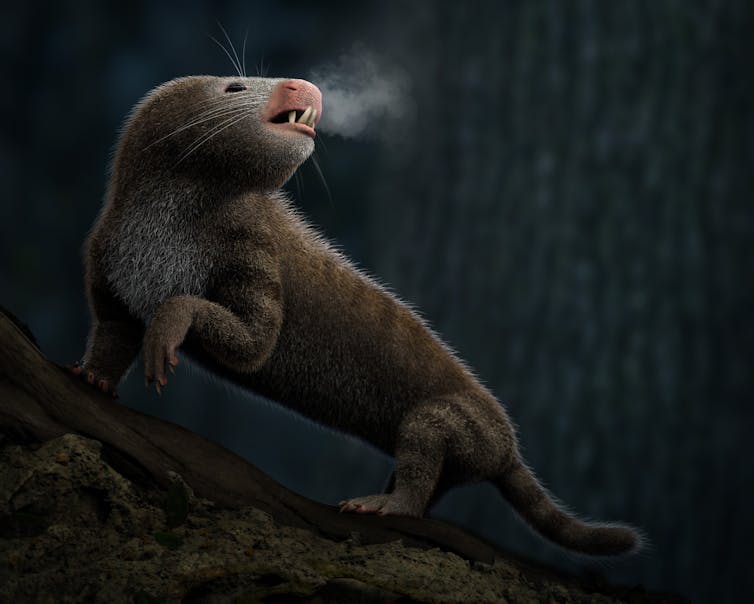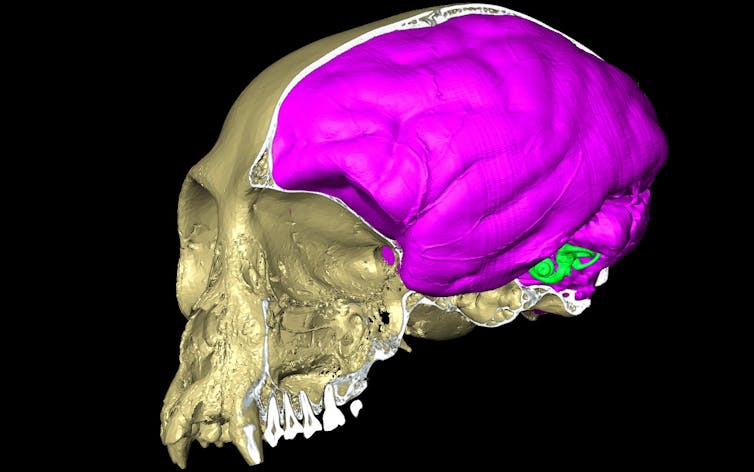
Mammals and birds produce their own body heat and control their body temperatures. This process is known as endothermy, or warm-bloodedness, and it may be one of the reasons why mammals tend to dominate almost every global ecosystem. Warm-blooded animals are more active during both days and nights than their cold-blooded counterparts and they reproduce faster.
But until now it hasn’t been known exactly when endothermy originated in mammalian ancestry. Our new study, just published in Nature, changes that. A combination of scientists’ intuition, fossils from South Africa’s Karoo region and cutting-edge technology has provided the answer: endothermy developed in mammalian ancestors about 233 million years ago during the Late Triassic period.
The origin of mammalian endothermy has been one of the great unsolved mysteries of palaeontology. Many different approaches have been used to try to pinpoint the answer but they have often given vague or conflicting results. We think our method shows real promise because it has been validated using a very large number of modern species. It suggests that endothermy evolved at a time when many other features of the mammalian body plan were also falling into place.
Warm-bloodedness is the key to what makes mammals what they are today. Endothermy was likely the starting point where mammalness evolved: the acquisition of an insulating fur coat; the evolution of a larger brain, supplied with warmer blood; a faster reproduction rate; and a more active life are all defining mammalian traits that evolved because of warm-bloodedness.
Until now, most scientists had speculated that the transition to endothermy was was a gradual, slow process over tens of millions of years beginning near the Permo-Triassic boundary, although some suggested it happened closer to the origin of mammals, about 200 million years ago.
In contrast, our results suggest that it appeared in mammalian ancestors some 33 million years prior to the origin of mammals. The new date is consistent with recent findings that many of the traits usually associated with “mammalness”, such as whiskers and fur, also evolved earlier than previously expected. And according to our results, endothermy evolved very quickly in geological terms, in less than a million years. We suggest that the process may have been triggered by novel mammal-like metabolic pathways and the origin of fur.
Scientists’ intuition
Our research began with Dr Araújo and Dr David’s intuition about the inner ear. It is more than the organ of hearing: it also houses the organ of balance, the semicircular canals.
The three semicircular canals of the inner ear are oriented in the three dimensions of space. They’re filled with a fluid that flows in the canals as the head moves and activates receptors to tell the brain the exact three-dimensional position of the head and body. The viscosity, or runniness, of this fluid (called the endolymph) is critical to the balance organ’s ability to efficiently detect head rotation and aid balance.

In the same way as a piece of butter turns from solid to liquid in a warm pan, or honey becomes thicker when it is cold, the viscosity of the endolymph changes with body temperature. That means the endolymph’s viscosity would normally be altered by the evolution of a higher body temperature. But the body has to adapt because changing viscosity would prevent the semicircular canals from working properly. In mammals, the canals adapt to higher body temperature by changing their geometry.
The researchers realised that this change in the semicircular canals’ shape would be easy to trace through geological time using fossils. Pinpointing the species in which the change of geometry occurred would, they reasoned, provide an accurate guide to when endothermy evolved.
They needed fossils to test their hypothesis – and that’s where South Africa’s wealth of fossils from the Karoo region came in.
Reconstruction and study
The arid Karoo region preserves a treasure trove of fossils, many of them belonging to mammalian ancestors. These fossils offer an unbroken record of the evolution of life over a period of almost 100 million years. They document the transformation from reptilian-like animals (therapsids) to mammals in exquisite detail.
Using cutting edge CT-scanning techniques and 3D modelling, we were able to reconstruct the inner ear of dozens of mammalian ancestors from the South African Karoo and elsewhere in the world. From there we could point out exactly which species had an inner ear anatomy consistent with a warmer body temperature, and which ones did not.
One thing we had to take into consideration was the geographical position of the Karoo at the time when these animals lived. It was situated closer to the South Pole than it is now as a result of continental drift. That means the warmer body temperature suggested by the geometry of the inner ear cannot be due to an overall warmer climate. As the South African climate was colder on average, the change in inner ear fluid viscosity can only have been caused by a generally warmer body temperature in mammalian ancestors.
An exciting time
This is an exciting time for our field. Until now, to reconstruct the evolution of endothermy, scientists only had access to skeletal features that questionably correlated with warm-bloodedness. Every attempt was a long shot to get any accurate results. The inner ear, as this research shows, changes this. We believe it may be the key to unlocking more knowledge about mammalian ancestors in future.
Julien Benoit, Senior Researcher in Vertebrate Palaeontology, University of the Witwatersrand; Kenneth D. Angielczyk, Lecturer, University of Chicago; Ricardo Miguel Nóbrega Araújo, Junior Researcher, Universidade de Lisboa , and Romain David, Postdoctoral Researcher, Natural History Museum
This article is republished from The Conversation under a Creative Commons license. Read the original article.











